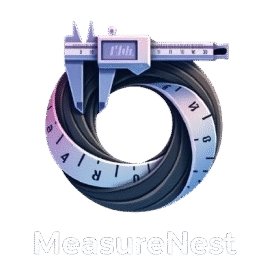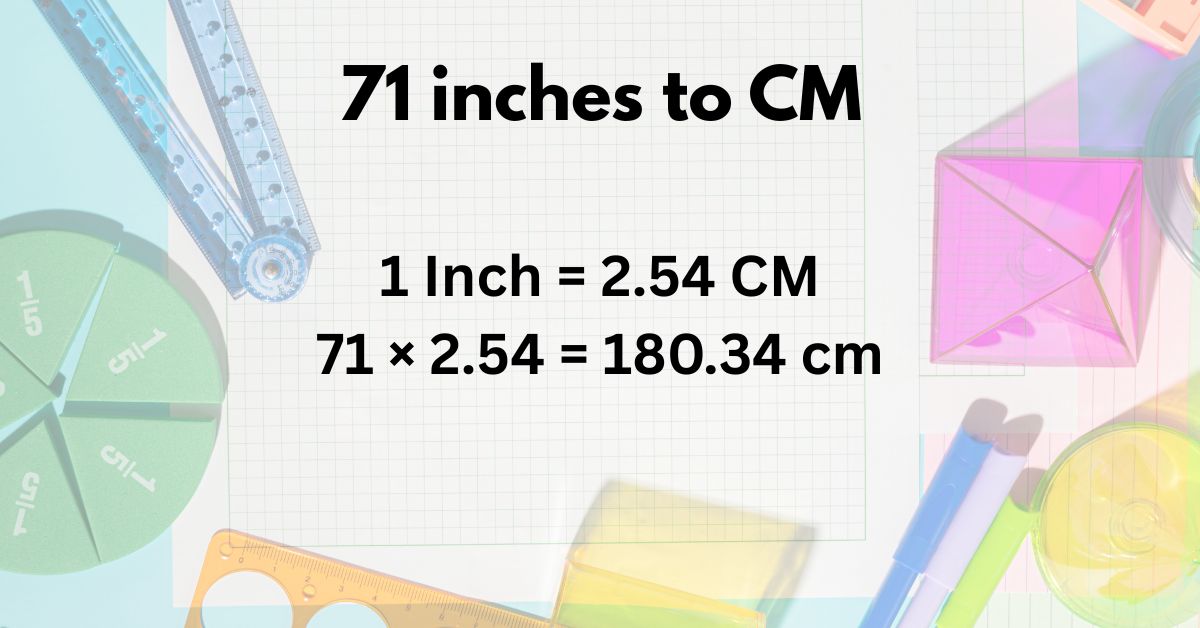Quick Answer: What is 71 Inches in CM?
71 inches is exactly equal to 180.34 centimeters.
This conversion uses the fixed ratio:
1 inch = 2.54 centimeters
71 × 2.54 = 180.34 cm
Knowing how to convert inches to centimeters is essential in engineering, international product sizing, and science fields. Whether you’re measuring height, screen size, or building materials, precise length conversions ensure accuracy.
71 Inches to CM Conversion Calculator
Conversion Formula: Inches to CM Explained
The Formula:
To convert inches to centimeters:
Centimeters = Inches × 2.54
This equation is universally accepted in the metric system. It is commonly used in construction plans, blueprint conversions, and dimensional accuracy in manufacturing.
Step-by-Step Conversion Example
Let’s break it down:
- Measurement: 71 inches
- Multiply by the conversion factor:
71 × 2.54 = 180.34 cm - Final Result: 71 inches = 180.34 centimeters
71 Inches in Other Units – Conversion Table
This table provides additional length conversions for 71 inches:
| Unit | Equivalent Value |
|---|---|
| Feet | 5.9167 ft |
| Yards | 1.9722 yd |
| Meters | 1.8034 m |
| Millimeters | 1803.4 mm |
| Micrometers | 1,803,400 µm |
| Kilometers | 0.001804 km |
| Miles | 0.00112 mi |
These units are useful when working with blueprints, technical specs, or international product sizing.
Real-Life Examples: How Long is 71 Inches?
Understanding 71 inches in the real world helps contextualize the measurement. Here are examples:
Common Items That Are About 71 Inches Long
- Flat-screen TV (Diagonal Measurement)
- Adult Height – 5’11”
- Standard Door Slab (Excluding Frame)
- Extended Aluminum Ladder Section
- Portable Kayak Seating Area
- Yoga Poles or Balance Bars
- Adjustable Weight Bench (Fully Extended)
Use Cases: Why Convert Inches to CM?
1. International Shopping and Trade
Products listed on Amazon, AliExpress, or eBay often use different unit systems depending on the country. Knowing how to convert inches to centimeters can help you choose the right-sized products.
2. Construction and DIY
If your tools are in metric but your blueprints use imperial units, conversions like 71 inches to cm help you avoid costly errors in measurements.
3. Science and Academia
In physics, biology, and medical fields, the metric system dominates. Conversion accuracy is vital for data integrity.
4. Travel and Personal Height
When filling out international forms or clothing sizes, knowing that 71 inches = 180.34 cm helps with accurate submissions.
Comparison: 71 Inches vs. 71 CM
| Metric | 71 Inches | 71 CM |
|---|---|---|
| Length in Centimeters | 180.34 cm | 71 cm |
| Length in Feet | 5.9167 ft | 2.33 ft |
| Use Case | Adult height, large items | Backpack size, small items |
Conclusion
Converting 71 inches to centimeters gives you a precise result of 180.34 cm, which is crucial across industries like engineering, education, and online retail. By mastering unit conversions, you eliminate guesswork and ensure measurement consistency in a globalized world.
Read More: 20 feet to inches
FAQs
How many centimeters is 71 inches tall?
71 inches tall is 180.34 centimeters, often used to express a person’s height or object length in the metric system.
Is 71 inches considered tall for a human?
Yes, 71 inches (or 5 feet 11 inches) is slightly above average adult male height in most countries.
How do you convert inches to centimeters manually?
Simply multiply the number of inches by 2.54. For example, 10 inches × 2.54 = 25.4 cm.
What is 71 inches in feet and inches?
71 inches equals 5 feet and 11 inches.
Why is knowing 71 inches in cm important?
It’s essential for accuracy in international business, academic research, manufacturing, and e-commerce.

Hi, I’m Daisy Wren, the creator of MeasureNest.info — your go-to hub for everything measurement-related.
With a deep interest in precision, tools, and practical knowledge, I started MeasureNest to simplify how people understand unit conversions, measuring devices, comparisons, and real-world applications. Whether figuring out the right dimensions, comparing measurement tools, or learning how to read them accurately, I break it all down simply, user-friendly.
My goal is to make measurement easy, useful, and even fun — whether you’re a student, DIY enthusiast, traveler, or just someone who wants reliable info without the guesswork.

